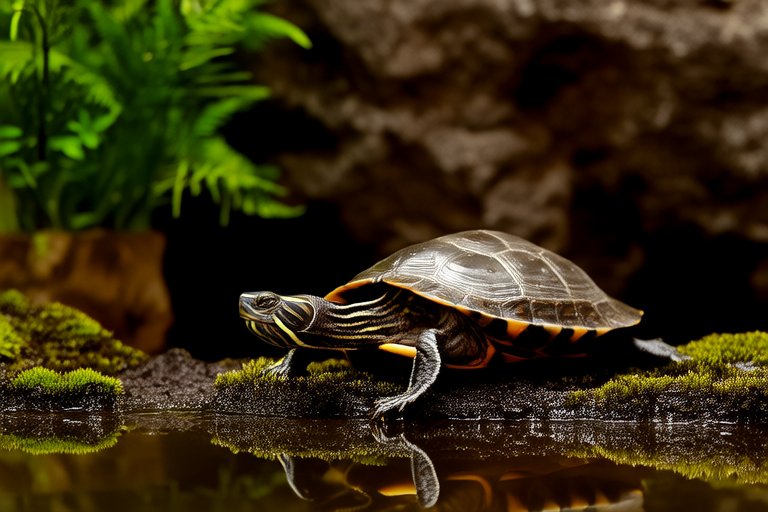Unveiling the Secrets of the Three-Striped Box Turtle Habitat Setup
The three-striped box turtle (Cuora trifasciata) is a captivating reptile native to parts of China, Taiwan, and Vietnam. These turtles are known for their striking appearance, with three distinct yellow stripes running down their dark shells. Proper habitat setup is crucial for their health and longevity. This comprehensive guide will walk you through setting up an ideal environment for your three-striped box turtle, covering everything from temperature and humidity to diet and maintenance.
Understanding the Natural Habitat
Before delving into specifics, it’s essential to understand where these turtles naturally live. In the wild, they inhabit forest floors with dense vegetation, rocky areas, and shallow water bodies. Their natural habitat provides clues about what conditions they need in captivity.
Ideal Temperature Range
Maintaining the correct temperature is vital for your turtle’s overall health. Three-striped box turtles require a temperature gradient within their enclosure to allow them to thermoregulate effectively. The basking area should reach between 85°F and 90°F (29°C – 32°C), while the cooler side of the tank can range from 70°F to 75°F (21°C – 24°C). Use a reliable thermometer to monitor temperatures at both ends of the enclosure.
Humidity Levels
Humidity plays a significant role in keeping your turtle hydrated and healthy. Aim for a relative humidity level between 60% and 80%. This mimics the moist environment they experience in nature. Regular misting or the use of a humidifier can help maintain these levels. However, ensure that the enclosure doesn’t become overly damp, which could lead to respiratory issues.
Lighting Requirements
Proper lighting is necessary for your turtle’s well-being. UVB light is particularly important as it aids in calcium absorption and vitamin D synthesis. A high-quality UVB bulb should be placed over the basking area, ensuring that it covers at least half of the enclosure. Replace the bulb every six months to maintain its effectiveness. Additionally, provide a full-spectrum fluorescent light for general illumination and a 12-hour light cycle to simulate day and night.
Substrate Types
Selecting the right substrate is crucial for your turtle’s comfort and safety. Avoid substrates like sand or gravel, which can cause impaction if ingested. Instead, opt for coconut fiber, cypress mulch, or reptile-safe bark chips. These materials hold moisture well, promoting humidity without becoming too soggy. Ensure the substrate is deep enough for your turtle to burrow but not so deep that it poses a risk of ingestion.
Hiding Spots
Providing hiding spots is essential for your turtle’s mental and physical health. Turtles need places to retreat when they feel stressed or want privacy. Incorporate half logs, cork flats, or commercially available reptile caves. Position these structures in various locations throughout the enclosure to give your turtle multiple options.
Water Area Setup
A dedicated water area is necessary for your turtle’s hydration and hygiene. The water should be deep enough for your turtle to fully submerge but not so deep that it poses a drowning risk. A water dish or small pond can serve this purpose. Change the water daily to prevent bacterial growth and keep it clean. Additionally, ensure the water area has smooth edges to prevent injuries.
Dietary Considerations
A balanced diet is key to your turtle’s health. Three-striped box turtles are omnivorous, consuming both plant matter and animal protein. Offer a variety of fresh vegetables such as leafy greens, carrots, and squash. Protein sources can include insects like crickets, mealworms, and earthworms. Commercial turtle pellets can supplement their diet but should not form the sole food source. Feed your turtle daily or every other day, adjusting portions based on their appetite.
Maintenance Tips
Maintaining cleanliness in your turtle’s habitat is critical for preventing disease and ensuring a healthy living environment. Clean the enclosure regularly, removing waste and uneaten food promptly. Perform a thorough cleaning every two weeks, disinfecting all surfaces with a reptile-safe cleaner. Rinse thoroughly and dry before reintroducing your turtle.
Monitor your turtle’s health closely, looking for signs of illness such as lethargy, loss of appetite, or abnormal behavior. Regular veterinary check-ups are recommended to catch any potential issues early. By following these guidelines, you’ll provide your three-striped box turtle with a thriving home that meets all its needs.
Conclusion
Creating an ideal habitat for your three-striped box turtle requires attention to detail and a commitment to providing the best possible care. By understanding their natural habitat and replicating key elements in captivity, you can ensure your turtle thrives. With the right setup and ongoing maintenance, your pet will enjoy a long and healthy life.
